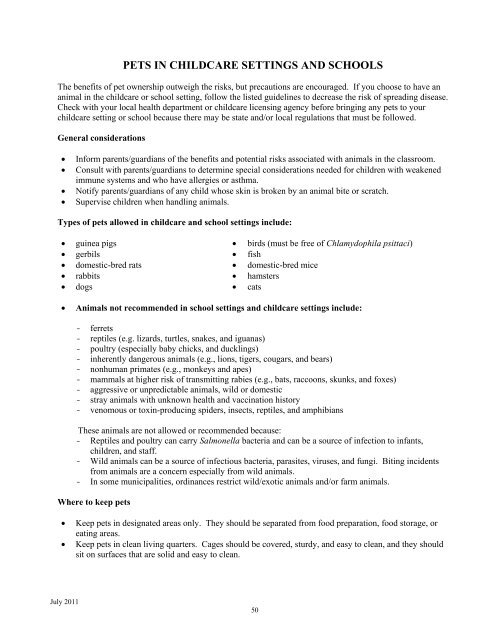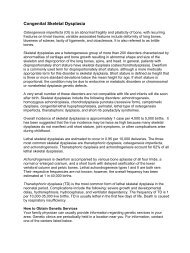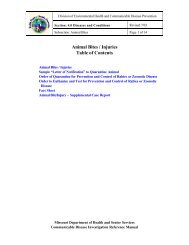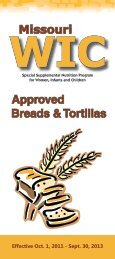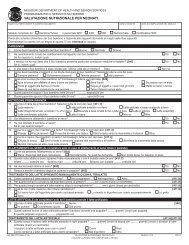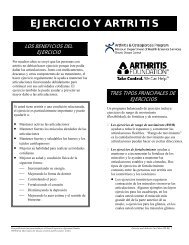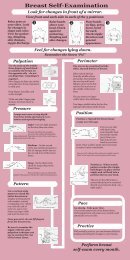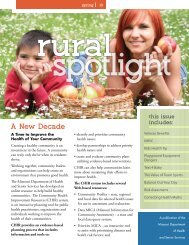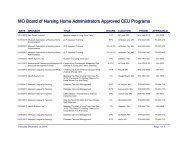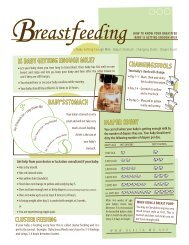Prevention and Control of Communicable Diseases - Missouri ...
Prevention and Control of Communicable Diseases - Missouri ...
Prevention and Control of Communicable Diseases - Missouri ...
You also want an ePaper? Increase the reach of your titles
YUMPU automatically turns print PDFs into web optimized ePapers that Google loves.
July 2011<br />
PETS IN CHILDCARE SETTINGS AND SCHOOLS<br />
The benefits <strong>of</strong> pet ownership outweigh the risks, but precautions are encouraged. If you choose to have an<br />
animal in the childcare or school setting, follow the listed guidelines to decrease the risk <strong>of</strong> spreading disease.<br />
Check with your local health department or childcare licensing agency before bringing any pets to your<br />
childcare setting or school because there may be state <strong>and</strong>/or local regulations that must be followed.<br />
General considerations<br />
� Inform parents/guardians <strong>of</strong> the benefits <strong>and</strong> potential risks associated with animals in the classroom.<br />
� Consult with parents/guardians to determine special considerations needed for children with weakened<br />
immune systems <strong>and</strong> who have allergies or asthma.<br />
� Notify parents/guardians <strong>of</strong> any child whose skin is broken by an animal bite or scratch.<br />
� Supervise children when h<strong>and</strong>ling animals.<br />
Types <strong>of</strong> pets allowed in childcare <strong>and</strong> school settings include:<br />
� guinea pigs<br />
� gerbils<br />
� domestic-bred rats<br />
� rabbits<br />
� dogs<br />
� birds (must be free <strong>of</strong> Chlamydophila psittaci)<br />
� fish<br />
� domestic-bred mice<br />
� hamsters<br />
� cats<br />
� Animals not recommended in school settings <strong>and</strong> childcare settings include:<br />
- ferrets<br />
- reptiles (e.g. lizards, turtles, snakes, <strong>and</strong> iguanas)<br />
- poultry (especially baby chicks, <strong>and</strong> ducklings)<br />
- inherently dangerous animals (e.g., lions, tigers, cougars, <strong>and</strong> bears)<br />
- nonhuman primates (e.g., monkeys <strong>and</strong> apes)<br />
- mammals at higher risk <strong>of</strong> transmitting rabies (e.g., bats, raccoons, skunks, <strong>and</strong> foxes)<br />
- aggressive or unpredictable animals, wild or domestic<br />
- stray animals with unknown health <strong>and</strong> vaccination history<br />
- venomous or toxin-producing spiders, insects, reptiles, <strong>and</strong> amphibians<br />
These animals are not allowed or recommended because:<br />
- Reptiles <strong>and</strong> poultry can carry Salmonella bacteria <strong>and</strong> can be a source <strong>of</strong> infection to infants,<br />
children, <strong>and</strong> staff.<br />
- Wild animals can be a source <strong>of</strong> infectious bacteria, parasites, viruses, <strong>and</strong> fungi. Biting incidents<br />
from animals are a concern especially from wild animals.<br />
- In some municipalities, ordinances restrict wild/exotic animals <strong>and</strong>/or farm animals.<br />
Where to keep pets<br />
� Keep pets in designated areas only. They should be separated from food preparation, food storage, or<br />
eating areas.<br />
� Keep pets in clean living quarters. Cages should be covered, sturdy, <strong>and</strong> easy to clean, <strong>and</strong> they should<br />
sit on surfaces that are solid <strong>and</strong> easy to clean.<br />
50


